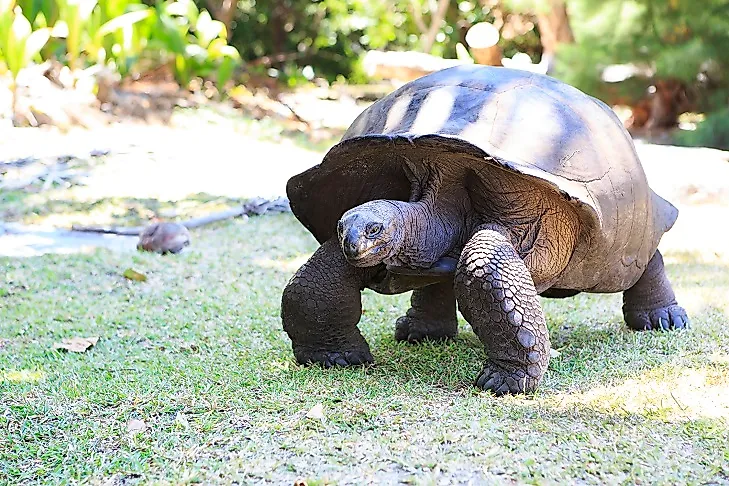Aldabra Atoll, Seychelles

The islands of Aldabra, the lagoon they surround, and their outlying coral reefs house thousands of giant tortoises along with other intriguing fauna. Being the second largest coral atoll in the world, Aldabra is the most far-flung island of the greater Seychelles Archipelago. Due to its remote location and lack of freshwater, the Atoll’s ecological processes have been uninterrupted by human activities. The Atoll was designated as a UNESCO World Heritage Site due to its biodiversity, scenic beauty, and land forms.
5. Climate and Geography-
The Aldabra Atoll is made up of 4 large islands and 40 smaller islands. Rising to an elevation of 8 meters, Aldabra Atoll is the largest raised coral reef to be found in the world. The Atoll stretches 13 kilometers wide and 34 kilometers long, and surrounds a lagoon that is 196 square kilometers in surface area. The larger islands of Aldabra Atoll are situated around the lagoon’s rim. The Atoll lies off the coast of Africa near Madagascar and Comoros Islands.The heaviest rainfall on the Atoll is recorded between November and March. On an annual basis, rainfall in the Atoll is recorded at an average of 960 millimeters. The Atoll is situated in the dry zone of the southwest Indian Ocean.
4. Natural History-
Most of the land surface of the Aldabra Atoll is made of exposed coral reefs. These have been continuously raised above sea level for the last 125,000 years.
3. Ecological and Scientific Significance -
The Aldabra Atoll represents one of the most significant natural habitats for research in ecological and evolutionary processes since it has been largely free from human interference through the years. Continuing ecological and biological processes provide the opportunity for scientific research. Over 400 flora and fauna species and subspecies reside on the island, and their ongoing interactions with nature present unique opportunities for scientific studies.
2. Habitats and Biodiversity -
The atoll is home to the largest population of giant tortoises in the world. Around 152,000 giant tortoises have been identified in the region. The Aldabra rail, the last flightless bird of the Western Indian Ocean, inhabits the Atoll. Flora and fauna in the Atoll exhibit a high level of endemism due to years of isolation. The Atoll is home to three endemic bat species. Namely, these are the Aldabra flying fox, Paratriaenops pauliani, and Chaerephon pusilla. The Mauritian tomb bat also inhabits the region. The hawksbill turtles and green turtles, both of which are endangered species, breed in the Atoll. The region also has one of the two world’s oceanic populations. The Aldabra Brush Warbler and Aldabra Drongo are two endemic bird species in the region. The Atoll boasts 19 endemic plants, including the Aldabra Lily and the Pandanus aldabrensis. The white mangrove, red mangrove, and black mangrove tree species occur on the shores of the lagoon. Higher elevations of the atoll are characterized by the pemphis shrub while shrubs, trees, and herbs dominate the lowlands.
1. Environmental Threats and Conservation Efforts-
The atoll’s ecosystems are largely undisturbed, although there have been emerging environmental concerns as of late. Climate change and invasive alien species have necessitated a high level of monitoring. The Seychelles Islands Foundation is tasked with the protection of the island, a duty the organization carries out efficiently. Tourism to the region is monitored and controlled, and no airstrips or tourism infrastructure has been permitted on the Atoll.











